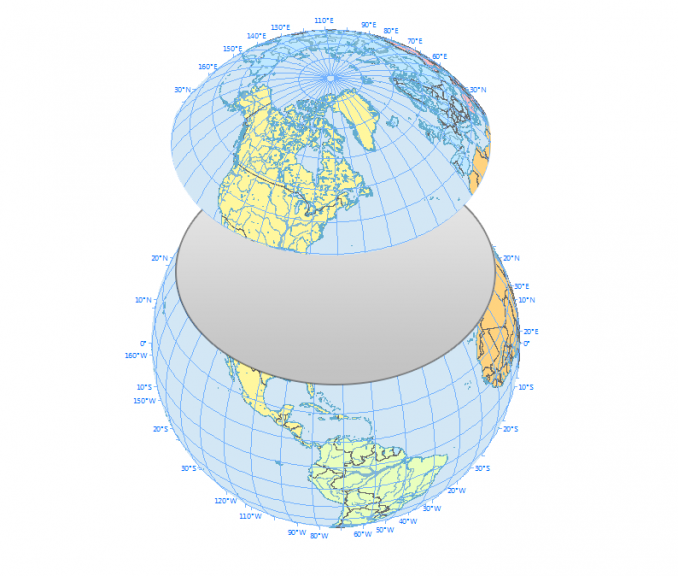Have you ever looked at a flight path on a map and wondered why airplanes take curved routes instead of flying in a straight line? Wouldn’t flying in a direct line be more fuel-efficient and faster? At first glance, it seems logical that a shorter distance would result in less fuel consumption, but in reality, aviation is far more complex.
Several factors determine flight paths, including the Earth’s shape, jet streams, weather conditions, and air traffic regulations. Let’s break down why airplanes rarely fly in a straight line and how their curved paths actually make flights more efficient.
The Earth’s Shape and the Great Circle Route

One of the biggest reasons airplanes don’t fly in a straight line is the Earth’s curvature. While we often view flight maps as flat, the Earth is a sphere, and the shortest path between two points is actually an arc called the Great Circle Route.
If you take a globe and use a string to connect two distant locations, you’ll notice that the shortest route often curves rather than follows a straight path. This is why flights from New York to Tokyo pass over the Arctic region rather than flying directly west across the Pacific Ocean.
Using the Great Circle Route helps planes save both time and fuel, even though it appears curved on a flat map.
Jet Streams and Weather Conditions Impact Flight Paths
Another key factor affecting airplane routes is jet streams—high-altitude wind currents that move at speeds of up to 200 mph (320 km/h). Pilots strategically plan routes to take advantage of these strong winds when possible.
Video : Why Airplanes Don’t Fly Straight
Flying with jet streams allows an airplane to get an extra push, helping it move faster while burning less fuel. Flying against a jet stream can slow down the plane significantly, increasing fuel consumption. Pilots often adjust routes to avoid strong headwinds, even if it means flying a longer distance.
Additionally, storms, turbulence, and severe weather conditions also play a role in determining flight paths. Airplanes may adjust mid-flight to bypass dangerous weather zones, thunderstorms, or areas with extreme turbulence.
Air Traffic Control and Flight Regulations
Air traffic isn’t a free-for-all where planes can just fly wherever they want. There are strict regulations set by aviation authorities and air traffic control (ATC) that dictate flight routes.
Some of these rules include restricted airspace, where certain areas, such as military zones, national security locations, and political zones, prohibit commercial flights from entering. Predefined flight corridors exist to avoid mid-air collisions, ensuring flights follow established air traffic lanes. Major airports handle hundreds of flights daily, so ATC ensures safe and efficient arrivals and departures.
Due to these regulations, airplanes cannot always take the most direct path and must follow designated routes instead.
Avoiding Air Turbulence for Passenger Comfort
Turbulence can make a flight uncomfortable, and pilots actively adjust routes to minimize rough air conditions. There are different types of turbulence, including thermal turbulence caused by warm air rising from the ground. Flying at higher altitudes helps avoid this.

Mechanical turbulence happens near mountains and rough terrains where wind patterns shift unpredictably. Clear-Air Turbulence (CAT) is sudden, strong air currents in high altitudes that are difficult to predict.
To ensure a smoother ride for passengers, pilots may deviate from the shortest path to avoid these turbulent areas.
Why Do Airplanes Sometimes Ascend Before Landing?
If you’ve ever been on a flight where the plane suddenly climbs just before landing, you might have felt a bit concerned. This maneuver is known as a go-around and is actually a common and safe aviation practice.
Some reasons why pilots perform a go-around include runway clearance issues. If another plane hasn’t cleared the runway in time, pilots must abort the landing and circle back. Poor weather conditions, such as poor visibility, strong crosswinds, or sudden gusts, can make a landing unsafe. If a plane is too fast, too high, or not properly aligned with the runway, the pilot will ascend and try again for a safer landing.
Go-arounds are standard procedures in aviation and ensure passenger safety above all else.
The World’s Longest Non-Stop Flight
While most flights follow curved paths, some routes push the limits of non-stop travel. The longest direct commercial flight in the world is from Singapore to Newark, New Jersey, USA.
This flight covers a distance of 10,400 miles (16,700 km) and takes approximately 18 hours and 45 minutes. It follows a carefully optimized path to balance fuel efficiency, wind conditions, and passenger comfort.
Video : Does Earth’s Rotation affect the Airplanes Speed & Flight Time
What Happens If a Plane Suddenly Loses Cabin Pressure?
A sudden drop in cabin pressure is often portrayed as a dramatic event in movies, but in reality, pilots are well-trained to handle it calmly.
When this happens, oxygen masks automatically deploy, and passengers should put them on immediately and breathe normally. The plane will descend to a safe altitude where oxygen levels are sufficient for breathing. The flight crew will assess the situation and communicate with passengers.
Losing cabin pressure doesn’t mean the plane will crash—pilots follow strict safety protocols to handle such incidents efficiently.
Final Thoughts: Why Curved Flight Paths Are More Efficient
While it may seem counterintuitive, airplanes take curved routes instead of straight lines to optimize flight efficiency, fuel usage, and passenger safety. Factors such as the Earth’s shape, jet streams, air traffic control, and weather conditions all play a crucial role in determining flight paths.
So next time you’re on a plane and see the route map displaying a curved flight path, remember there’s a lot of science and planning behind it to ensure you reach your destination as safely and efficiently as possible.
Why Sydney Sweeney Regarded by Science As the Most Attractive Woman on Earth
Sydney Sweeney, celebrated for her performances in hit shows like Euphoria and The Handmaid’s Tale, has emerged as a beauty icon in Hollywood. But what exactly makes her so captivating? Let’s explore the science behind her allure.
She was insecure about her looks in high school.

Sydney’s journey began in high school when she made a decision she never regretted. Thinking back on her past, Sweeney mentioned that she developed earlier than other girls in middle school, leading to self-esteem issues. “I used to feel uncomfortable,” she said, considering breast reduction, but her mom persuaded her otherwise.
Playing Cassie in the show was a big confidence boost for her. Despite these challenges, she faced them bravely, growing into a successful actress in Hollywood. Later, she captured headlines due to chemistry with co-star Glen Powell, though both dismissed the dating rumors.
Some people don’t believe she has a natural look.

There’s been speculation about the extent of Syndey Sweeney’s natural beauty, prompting questions about whether she’s had plastic surgery. Two dermatology experts have weighed in on the matter.
Emma Coleman, a dermatology and aesthetic RGN at Emma Coleman Skin, suggested, “In my professional opinion, Syndey Sweeney has had Botox and possibly a brow lift.” She also noted signs of mud face rejuvenation with hyaluronic acid dermal filler and cheek implants.
However, not all professionals agree. Dr. Olya Vorodyukhina, an aesthetics trainer and founder of Angels Twelve clinic, expressed skepticism, stating that at Sydney’s young age, it’s unlikely she’s undergone any procedures.
What are the perfect body proportions?

Plastic surgeon Onur Gilleard explains it as a “golden ratio” of facial proportions. Sydney’s features, he says, embody symmetry and harmony, a hallmark of classical beauty. Dr. Gilleard elaborates: “The golden ratio in facial proportions can be applied both horizontally, known as the ‘rule of fifths,’ and vertically, known as the ‘rule of thirds.’”

For instance, a beautiful nose should have a gentle curve and proper projection. The angle between the nose and lip is critical, ideally falling between 95–100 degrees. Viewing from the front, the width of the nose should match the inner eye distance, with the nasal tip being a third of the total width.
Similarly, lips should be proportionate to the nose, with the upper lip’s vertical height matching 1:1.6 with the lower lip. The ideal chin position is around 1mm behind a line dropped from the upper lip. High, defined cheekbones also play a significant role in female attractiveness.

Analyzing Sydney’s face, Dr. Gilleard notes that she meets nearly all these criteria, earning her the title of a “classical beauty.” “Sydney Sweeney’s beauty extends beyond her facial features. Her figure, too, embodies ideal proportions, reflecting the same ‘golden ratio.’” Despite her physical attributes, Sydney advocates for body confidence, encouraging everyone to embrace their unique beauty.

People often create lists of the most beautiful women or men in the world or those with perfect bodies, whether based on science or personal opinion. However, it’s crucial to remember that true beauty comes from feeling confident and accepting yourself.



Leave a Reply